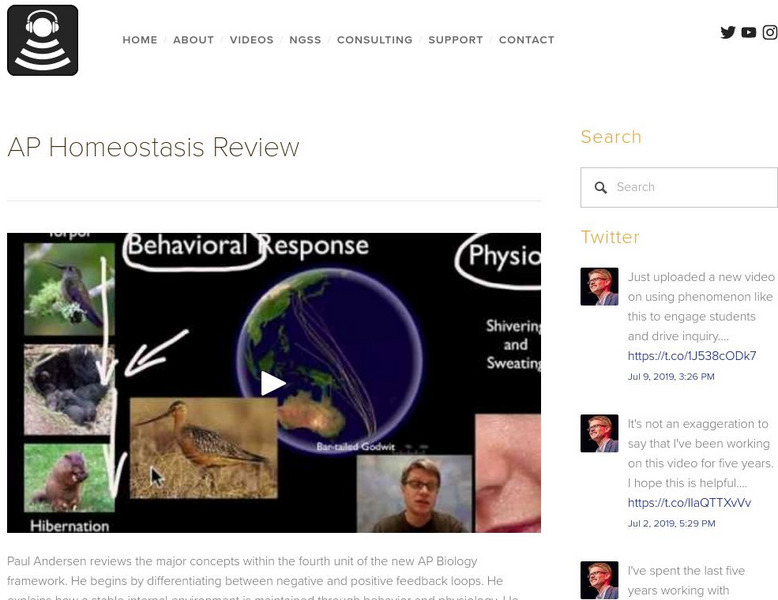Bozeman Science
Positive and Negative Feedback Loops
Paul Andersen explains how feedback loops allow living organisms to maintain homeostasis. He uses thermoregulation in mammals to explain how a negative feedback loop functions. He uses fruit ripening to explain how a positive feedback...
Bozeman Science
AP Biology Practice 7 - Connecting Knowledge
In this video Paul Andersen explains the final AP Biology practice on connecting knowledge. The video begins with an introduction to interdisciplinary studies and how science is changing over time. He describes differences of scale in...
Professor Dave Explains
Practice Problem: Comparing Gravitational Forces
Gravity is mysterious, isn't it? If all matter exerts gravity, why don't we all just drift towards each other all the time? Well, as you know, it depends on the masses of the two objects and the distance between them. Your friend says...
SciShow
The 2017 Nobel Prizes: Biological Clocks and Microscopy
Last week, the recipients of the 2017 Nobel Prizes were announced. We take a closer look at the winners of the Physiology and Chemistry Awards, whose breakthroughs change the way we study sleep, and allow us to look at microscopic...
Curated Video
Writing Effective Response Openings: Hooking the Reader and Stating Your Argument
In this video, the teacher provides guidance on how to begin a response to a writing prompt. They emphasize the importance of hooking the reader and clearly stating the thesis statement. The teacher also highlights the need to consider...
Curated Video
GCSE Biology - Control of Blood Glucose Concentration #56
Learn how the body controls it's blood glucose concentration using the hormones insulin and glucagon. We'll also see how these two hormones interact in a negative feedback loop.
Crash Course
Great Glands - Your Endocrine System: CrashCourse Biology
Hank fills us in on the endocrine system - the system of glands which produce and secrete different types of hormones directly into the bloodstream to regulate the body's growth, metabolism, and sexual development & function.
Curated Video
Uses of Plant Hormones | Plants | Biology | FuseSchool
Uses of Plant Hormones | Plants | Biology | FuseSchool In this video we are going to look at a few different ways in which plant hormones can be used. Plant growth hormones (auxins) can be used as selective weedkillers. The selective...
Bozeman Science
Thermoregulation
Paul Andersen explains how organisms are able to regulate their internal body temperature (or not). He starts with a brief description conduction, convection, radiation and metabolism. He contrasts ectotherms and endotherms. He also...
Curated Video
Hormones: Adrenaline and Thyroxine
This video discusses two hormones produced by the body: adrenaline and thyroxine. The video provides an explanation of what hormones are, how they work, and the effects of adrenaline and thyroxine on the body. It also includes...
Curated Video
Understanding Measures of Center and Variance in Real World Data
Understand the difference between the measure of center and the measure of variance. Learn how these measures can be used in everyday life through a real-world example of basketball scores and review how different measures of tendency...
Amoeba Sisters
Homeostasis and Negative/Positive Feedback
We all need a little feedback, both positive and negative! Take on one of the trickier Biology 1 concepts using a thoughtfully worded video from a fantastic biology playlist. The narrator explains both types of feedback with plenty of...
Amoeba Sisters
Characteristics of Life
What makes a living thing, well, living? Explore the many characteristics of living things through an animated video. Science scholars become acquainted with the obvious and not-so-obvious traits exhibited by organisms, then learn that...
Howard Hughes Medical Institute
The Mammalian Molecular Clock Model
Animals don't read clocks, so how do they know when it is time for eating, sleeping, and other cyclical needs? Viewers watch an animation of the genes and the molecular clocks inside most mammals. They compare the difference in wild...
Bozeman Science
Bozeman Science: Ap Homeostasis Review
Paul Andersen reviews the major concepts within the fourth unit of the new AP Biology framework. He begins by differentiating between negative and positive feedback loops. He explains how a stable internal environment is maintained...





